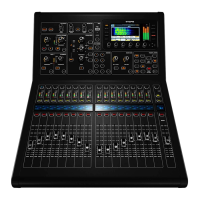33 DIGITAL RACK MIXER M32R User Manual
home
The EFFECTS screen’s home tab provides a high-level overview of the eight
eects processor slots, giving the user at-a-glance feedback on the eects they
have assigned to the slots, the console source and destination for each processor,
and the input/output levels for each processor.
To make adjustments on the EFFECTS screen’s home tab, perform the
following steps:
1. Adjust the rst push encoder to select the input source for the currently
highlighted eects block. Signal path choices include:
• Insert Send
• Mix Bus 1-16.
2. Tap the rst encoder to assign the currently selected input source.
3. Adjust the second encoder to select the input source for the right side of
the currently highlighted eects block.
4. Tap the second encoder to assign the currently selected input source.
TIP: To congure an eect as mono input and stereo output, set both input
sources to the same signal path
5. Tap the third and fourth encoders to mute the currently selected eect.
6. Adjust the fth encoder to scroll among the dierent audio eects
available. Choices include:
Hall Reverb Delay + Chamber M/S Fair Comp
Ambience Chorus + Chamber Dual Fair Comp
Rich Plate Reverb Flanger + Chamber Leisure Comp
Room Reverb Delay + Chorus Dual Leisure Comp
Chamber Reverb Delay + Flanger Ultimo Comp
Plate Reverb Modulation Delay Dual Ultimo Comp
Vintage Reverb Dual Graphic EQ Dual Enhancer
Vintage Room Stereo Graphic EQ Stereo Enhancer
Gated Reverb Dual TruEQ Dual Exciter
Reverse Reverb Stereo TruEQ Stereo Exciter
Stereo Delay Dual DeEsser Stereo Imager
Triple Delay Stereo DeEsser Edison EX1
Rhythm Delay Stereo Xtec EQ1 Sound Maxer
Stereo Chorus Dual Xtec EQ1 Dual Guitar Amp
Stereo Flanger Stereo Xtec EQ5 Stereo Guitar Amp
Stereo Phaser Dual Xtec EQ5 Dual Tube Stage
Dimension-C Wave Designer Stereo Tube Stage
Mood Filter Precision Limiter Dual Pitch Shifter
Rotary Speaker Combinator Stereo Pitch
Tremolo / Panner Dual Combinator
Suboctaver Fair Comp
7. Tap the fth encoder to assign the selected eect to the currently
highlighted eects slot.
8. Adjust the sixth encoder to scroll among the eight eects slots to select
one for editing.
9. Tap the sixth encoder to go to the edit page for the currently
highlighted eects slot.
fx1-8
The EFFECTS screen’s fx 1-8 tabs allow you to edit the parameters for the specic
eect processor assigned to the corresponding eects slot.
In order to more closely simulate the look and feel of the outboard processors
that are no longer necessary with a digital console, the individual eects
processor screen provides a graphical representation of the eects processor’s
real world physical counterpart. This provides greater ease of use for the user
than a simple text list of parameters.
To make adjustments on the EFFECTS screen’s editing tab, perform the
following steps:
1. Adjust the six push encoders to change the various eects parameters
shown at the bottom of the screen.
2. Use the Up/Down navigation controls to switch the push encoders to a
second, third or fourth set of parameters for eects that contain more
than six adjustable parameters.
3. When the eects processor has been edited to your satisfaction, push
the sixth encoder to go back to the EFFECTS screen’s home tab.
4. See the Main Display - Internal Eects section for more details on
specic eects and parameters.
TIP: For the Graphics EQ eects, tap the rst push encoder to implement the
‘Graphics EQ on Faders’ function. This allows you to boost or cut the dierent
EQ bands using the eight console output faders, eight faders at a time, with the
relevant EQ bands displayed on the channel LCD screens.
Adding one of the 8 internal eects
There are two types of eects that are commonly used:
• “Eects Loop” (side chain) style eects, where multiple channels all send
varying amounts of their signal to a common eect, such as a reverb,
delay, or chorus.
• “Insert” style eects that are inserted in to the signal path of a single
channel of audio. Examples would be a graphic EQ, lter, exciter,
or tube emulator.
To apply an “Eects Loop” style eect:
• Press the “FX” menu button. The main screen will show the FX home screen
where dierent eects processors are assigned to the 8 processing slots.
• Adjust rotary encoder #6 to highlight the rst eects processor; it will be
surrounded by an orange outline.
• Adjust rotary encoder #1 and rotary encoder #2, selecting your desired bus
as the source for both the left and right inputs of the rst eect processor.
By default, FX 1 is sourced from Bus 13.
• Adjust rotary encoder #5 to select a specic eect processor,
such as “Ambience”.
• Select the fader bank button labeled “RTN” on the left side of the console.
Bring the faders labeled FX1L and FX1R up to 0 dB in case they are not set to
this value by default. In the initial setup, these returns are stereo linked and
automatically send to the main LR bus, but it is also possible to send them to
the other buses as well. For this, press the HOME button next to the screen
while the return is selected, then go to the SENDS tab with the PAGE SELECT
right button and adjust the send levels for the return to the other buses,
or use the dedicated BUS SENDS controls.

